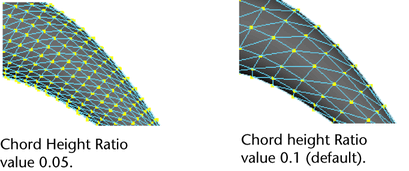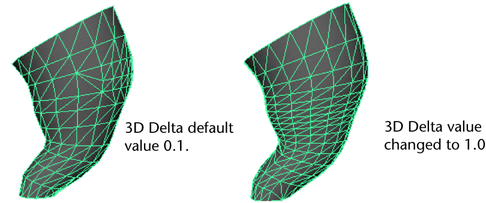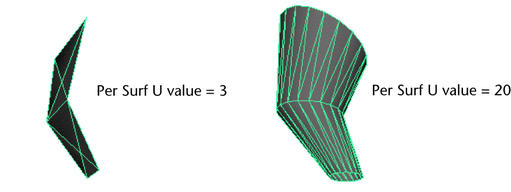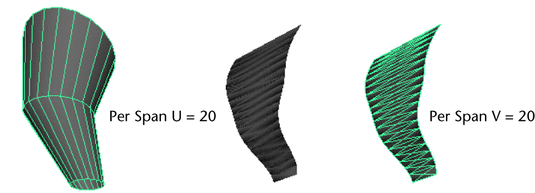Use the following options to set what happens when you select Modify > Convert > NURBS to Polygons. See also Convert NURBS surfaces to a polygon mesh.
Attaching multiple output meshes
- Attach Multiple Output Meshes
-
Produces a single mesh, even if the original NURBS object consists of separate surfaces.
For example, if you convert a NURBS cube (which consists of six separate faces) with Attach Multiple Output Meshes on, the resulting polygon cube will consist of a single mesh. If Attach Multiple Output Meshes is off, the polygon cube will consist of six separate meshes.
- Merge Tolerance
-
Controls how close vertices must be in order to be merged into a single mesh (when Attach Multiple Output Meshes is on).
- Match Render Tessellation
-
When Match Render Tessellation is turned on it uses the existing render tessellation values that are set for the NURBS surface when converting it to a polygon mesh. As a result, the converted polygon mesh will match the rendered version of the NURBS surface. When History is turned on the NURBS to Polygon conversion will update whenever the NURBS render tessellation values are modified.
Outputting to triangles or quads
- Type
-
Select the type of polygons to use when you convert NURBS geometry to polygonal data.
If you select Triangle (the default), 3-sided polygons are created. If you select Quads, 4-sided polygons are created.
 Note:
Note:When you tessellate a trimmed NURBS surface, some 3-sided (triangle) polygons may be created along the trim edge even when the option is set to Quads.
Choosing a tessellation method
Tessellation means that you create a set of polygons from NURBS geometry. Each tessellation method provides you with options that let you control the resulting polygonal surface.
There are four tessellation methods: “Standard fit”, “General”, “Count”, and “Control Points”.
Standard fit
Standard Fit is the default tessellation method. It is “adaptive” tessellation, meaning that the following options are used to determine when to stop the tessellation.
For example, the tessellation stops at the Fractional Tolerance value you set. If there is an edge shorter than the Minimal Edge Length, the tessellation stops on that edge. If the surface is flat enough within the edge (the specified chord/height ratio is small enough), the tessellation stops there.
- Chord Height Ratio
-
The Chord Height Ratio is the ratio between the maximum distance of the curve from the polygon edge used to approximate it and the chord length. The chord length is the linear distance between two polygon vertices.

Valid values range between 0 and 1, where larger values result in fewer polygon vertices.
For example, the default value, 0.1, means that the height must be larger than 1/10 of the chord length before additional edit points are created.
- Fractional Tolerance
-
The Fractional Tolerance value determines the degree of accuracy maintained between the original surface and the interpolated polygonal surfaces. The default is to be accurate to within 0.01 units, where a unit refers to the current unit of linear measure (the default unit of measure is centimeters). Therefore, at no point will the polygonal surface be more than the tolerance distance away from the original NURBS surface.
In this next example, notice how you can enhance the polygonal surface’s accuracy when you change the Fractional Tolerance value from 1 to 0.01.

- Minimal Edge Length
-
Enter a value or use the Minimal Edge Length slider to set the minimum length of the edges of the triangles or quads that are created.
- 3D Delta
-
The 3D Delta value determines the 3D spacing for U and V isoparms on a surface that makes up the initial grid for the tessellation. In the following example, the 3D Delta value is changed from the default 0.1 to 1.0.

General
Set the Tessellation Method to General to display the following options.
Setting the initial tessellation controls
Unless Use Chord Height or Use Chord Height Ratio is turned on, a uniform tessellation is performed. Each span/surface is split into a number of polygons depending on the Number U and V values you set.
- U Type/V Type
-
The U Type and V Type pop-up menu items let you specify whether you want to split the surface based on where the spans are (then split each span), or based on the parameterization of the whole surface.

- Number U/Number V
-
Each span or surface is split into the number of polygons you specify here.

Specifying the secondary tessellation controls
If Use Chord Height or Use Chord Height Ratio is turned on, you can set a specific value for both the Chord Height and the Chord Height Ratio. A value greater than 0 results in fewer polygon vertices if the ratio on the curve is greater than the current value. For example, the default value, 0.1, means that the height must be larger than 1/10 of the chord length before additional edit points are created.
Turn Edge Swap on to produce triangles with the opposite orientation for the final quadrilateral.
Count
Set the Tessellation Method to Count to display the following slider.
- Count slider
-
Use the Count slider to determine how many polygons the surface can be tessellated into. See the following examples.

Control Points
This tessellation method converts the NURBS model to polygons while matching the CVs of the original NURBS surface. There are no other options for this operation.

Notes
When you use the Control PointsTessellation Method:
- The Type option you set is ignored and the resulting polygon is in Quads by default.
- If you convert trimmed NURBS surfaces the surfaces convert as though they were not trimmed.
When you use the Attach Multiple Output Meshes option, the operation may fail to attach surfaces for a variety of reasons:
- When attaching a number of surfaces, and some of the surfaces are extremely small, the tolerance must be set to an appropriately small value or the attach operation will fail.
- When attaching multiple surfaces, all of the surfaces must be contiguous to within the user-defined tolerance. Separated regions cannot be attached in a single operation. Use the attach operation multiple times for this case; once for each contiguous region.
- The surfaces to be attached must have their normals facing in the same direction or the attach will fail.